If you’re anything like most people visiting this blog, you’re probably sick of hearing about pet cats and dogs. Whether you’re allergic to animal hair or want a pet that’s a little easier to care for, one of these pet reptiles is a perfect alternative.
Reptiles can make wonderful and interesting pets, though you may be wondering what the best pet reptiles are. Luckily, this blog post covers just that!
A note on the best pet reptiles
This list doesn’t just include the easiest reptiles to keep, we’ve tried to add a mix of easy and more advanced pet reptiles to mix things up a little. If you’re looking to get a pet reptile and it’s your first time caring for one, then go for an easier species first so you’re sure you take care of your new pet reptile well!
Table of Contents
Bearded dragon

In a list of the best reptiles to keep as pets, the bearded dragon couldn’t be left out!
These calm and funky-looking chaps are great reptiles to keep as pets. They natively come from Australia but are bred as pets all across the world. They’re quite easy to get hold of and aren’t going to cost you an arm and a leg initially. They’re one of the most popular pet reptiles, so we’re sure you’ve heard of them before if you’re reading this post.
Being native to Australia, bearded dragons need a good source of heat to bask in. They eat both insects and plants and move more towards a plant-based diet as they grow older.
Size: The average size of a bearded dragon depends on the species and gender, but usually falls between 15 and 25 inches.
Care: Bearded dragons are relatively hardy species and are easy to care for. They’re a great pet for beginners as they are gentle, small and not too many special requirements. Check out our bearded dragon care guide for more info!
Life expectancy: It’s not uncommon for a bearded dragon to live to the ripe old age of 10! This means you’ll be feeding and caring for them for some time to come if you do go for a beardie.
Cost: bearded dragons aren’t an expensive reptile to keep. They aren’t very hard to breed so are normally readily available in most reptile shops or even online!
On top of this, the largest cost, depending on the cost of electricity where you live, is the heating. Beardies need a good heat source and that can add up during the years they live for.
Overall, bearded dragons make great pets and are beginner-friendly too. One that couldn’t be forgotten!
Leopard gecko
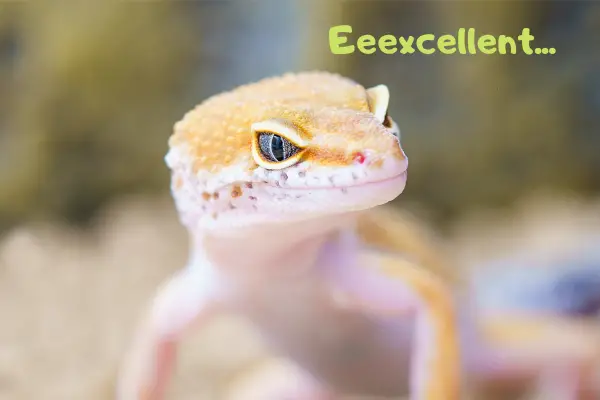
Next on our list of the best pet reptiles is the leopard gecko. These cute little critters are sure to melt your heart and are beginner-friendly too!
Leopard geckos natively come from areas around India and Pakistan, where they live in warm and rocky environments. These geckos aren’t a fan of vegetarianism and love to feed on things like crickets, mealworms and super worms.
Unlike many other species of gecko, leopard geckos don’t possess the ability to climb on vertical surfaces. That being said, they can be quite the escape artist as I’ve witnessed first-hand in the past!
Size: Leopard geckos are relatively large when compared to most other geckos but are still quite small pet reptiles. They grow to be about 7-11 inches.
Care: Leopard geckos are easy to care for and a relatively hardy reptile. They are a very popular pet reptile and they are great for beginners due to the lack of special requirements needed for these pets.
Life expectancy: With a life expectancy of 6-10 years but some even make it to be 15 or even 20! As you can see, these geckos are going to be your friend for a long time. If they reach the 2-year mark in healthy fashion, they have a good chance of reaching a reasonable age.
Cost: Just as with the bearded dragon, these geckos aren’t expensive to purchase. The largest cost is the heat lamp needed to keep your leo alive and healthy.
Another great addition to this list and certainly one to consider if it’s your first time owning a reptile. They’re extremely popular among both beginners as well as more experienced lizard owners and can be classed as one fo the best pet lizards for sure!
Russian tortoise
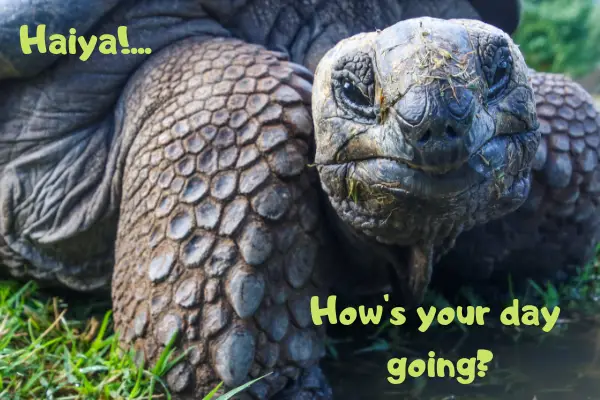
If you’re looking for a good reptile to keep as a pet, then the Russian tortoise is a great option for you.
These tortoises are native to Central-Asia and are commonly kept as pets. My personal experience with tortoises is that the hibernation period can be a little tense, but they are very rewarding reptiles to keep as pets.
They love eating fruits and vegetables. Vegetables are their staple food since they provide the highest level of nutrition and usually aren’t too high in sugar.
Being reptiles, they are obviously cold-blooded. Russian tortoises do well at normal room temperatures, but a basking spot with overhead heat lamps help them to thermoregulate. They’re actually surprisingly fast once they’re fully warmed up!
Size: When it comes to size, Russian tortoise females are a little larger than males. They generally reach a size of about 8 to 10 inches.
Care: Russian tortoises aren’t all too hard to care for, but they do come with their own challenges. As long as you do your research then you should be fine when caring for one.
Life expectancy: Russian tortoises can live to the ripe old age of 40! Yes, you read that right… It’s a big decision to get a tortoise and a lot of people tend to go for older tortoises instead of youngsters for this exact reason.
Cost: As with most reptiles, heating is the most expensive cost when it comes to Russian tortoises. They cost about $50 to $100 to buy, and the total setup costs are around $100-$250 depending on the choices you make.
Red eared slider

From tortoises to turtles, the red eared slider is another great pet reptile! These turtles can walk on land just like tortoises, but they swim graciously too and love the water.
Not to be mistaken for the yummy parmesan slider, red eared sliders are native to Mexico and the south-east United States. They are extremely popular pets all over the world and it’s more than likely that you’ve seen them in someone’s house or pond before.
Red eared sliders eat mostly commercial turtle food in captivity, but they love to eat live insects like crickets, mealworms and a whole host of other water and land-based prey. They also eat vegetables and aquatic plants.
Size: These turtles can grow to 12 inches in length. That’s around 30cm’s! Once they reach that size, they need quite the tank too so be aware of this and make sure you have the space.
Care: Red eared sliders are also relatively easy to care for if you do your research. I guess this is true for most reptiles on this list.
Life expectancy: These turtles can reach the age of 20 years. This means you’ll be caring for them and enjoying them way into the future!
Cost: Red eared sliders only cost about $10 to $40 in pet stores. The only extra cost they need compared to other reptiles is a water heating unit. This adds to the electricity bill and can really add up together with a basking light.
Ball python
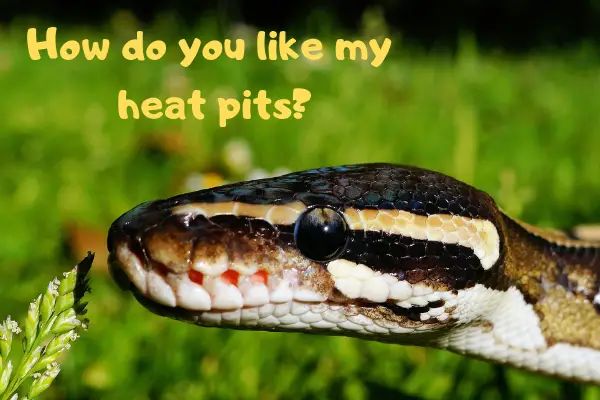
Ball pythons are certainly one of the best reptiles to keep as pets when it comes to snakes! They are an extremely popular snake species to keep too, being by far one of the top 2 most kept snakes, along with the corn snake.
Ball pythons are native to Sub-saharan Africa. They are one of the smallest of pythons in Africa and are extremely beautiful creatures to look at.
These snakes make great pets as they have a very docile temperament. Be careful though, snakes are great at finding escape routes out of their enclosure!
You should always make sure that your terrarium is “snake-proof” and there are no escape points for them to wriggle out of.
Because of their temperament, these snakes are easy to handle. They may feel kind of strange but, once they are used to you, they don’t tend to cause any problems.
A ball pythons diet consists mainly of mice and rats. The sizes of the pray animal will vary depending on how old and large the python is.
Size: Ball pythons reach the size of roughly 2 to 5 feet, depending on if it’s a male or a female, and on the genetics of the animal.
Care: Again, as long as you do the proper research before buying your pet ball python, they are easy pets to care for. More info on ball python care can be found here.
Life expectancy: On average, these snakes live to be about 20-30 in captivity, but there have been cases where they surpass the 40 years. As with most reptiles, these animals are long-lived.
Cost: Normal morphs sell for anything from $30 to $100, but there are extremely rare and popular morphs that sell for much higher prices. The price of the feeder animals is a bit higher than insectivores, but the heating costs are the same.
Chinese water dragon
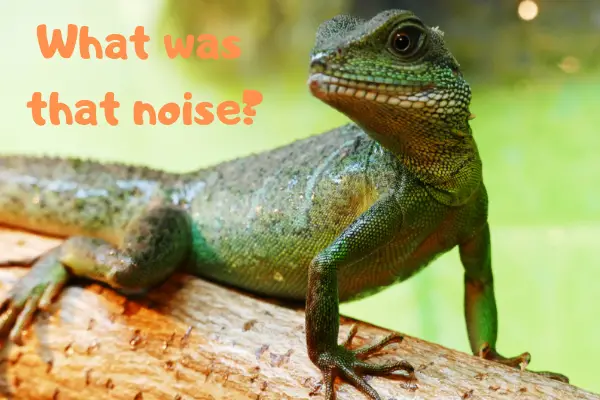
When you think of good reptile pets, the Chinese water dragon is a reptile that commonly comes up. They are active little fellas who originate from south east Asia.
These animals are quite care-intensive, and probably won’t be your first choice if you’re new to reptile keeping.
That being said, they are a rewarding reptile to keep!
Chinese water dragons eat mostly insects and are avid hunters. However, they do indulge in other food sources like vegetables and fruits.
Their staple food is insects though, and that’s the main thing that you’ll be feeding these little dragons.
Size: Water dragons can reach a whole meter in length! This may sound huge, but when you consider that well over half of this length is the tail, it’s not as impressive.
Care: These lizards aren’t extremely difficult to care for but do have some needs that need to be tailored exactly to the animal. If you do your research well, then it’s very doable to keep these animals as pets.
Life expectancy: On average, Chinese water dragons reach about 10-15 years of ages. Some have even lived to 20+ years though!
Cost: Chinese water dragons aren’t that expensive to purchase. Their setup isn’t that much either. The only thing to keep in mind, as is the trend in this blog post, are the costs for feeding and heating.
Overall, Chinese water dragons make great pets and are a beautiful species to study!
Crested gecko

If you’re looking for a gecko that’s into climbing, then the crested gecko is a great option for you!
Crested geckos are one of the largest species of gecko around. They are native to Southern new Caledonia, which is a group of islands in the southwest pacific, off the coast of Australia.
Crested geckos are quite the climbers and are a beautiful species of gecko to house as a pet.
In the wild, these animals are actually an endangered species. Even though they are endangered in the wild, crested geckos are one of the most commonly kept geckos as pets.
Crested g
Size: Crested geckos can reach up to 25 centimetres (10 inches) and are one of the larges gecko species there are. Their tail makes up a large chunk of this length.
Care: Crested geckos are relatively easy to care for and are great for first-time reptile keepers. As long as you do your research on how to care for them properly, you should face too many problems in raising a healthy crested gecko.
Life expectancy: Crested geckos can reach 15 years or more if cared for well and they don’t face any health issues. As with all reptiles, it’s always best to think carefully before taking one on as a pet as they tend to live for quite a long time.
Cost: Crested geckos may be one of the cheapest pet reptiles you can get on this list. They do not need heating as long as they are kept in a heated room so your monthly costs should be very low. They are priced somewhere between $30 and $100, depending on the supply and demand in your area, as well as the morph you end up going for.
Fun crested gecko fact: Crested geckos actually have the ability to drop their tail, just like most other geckos. However, unlike in species like the leopard gecko, the tail doesn’t grow back!
This is not harmful for the gecko so it’s not a big problem. Just be careful if you do own one as a pet as it would be a shame if your crested gecko lost its beautiful tail.
Corn snake
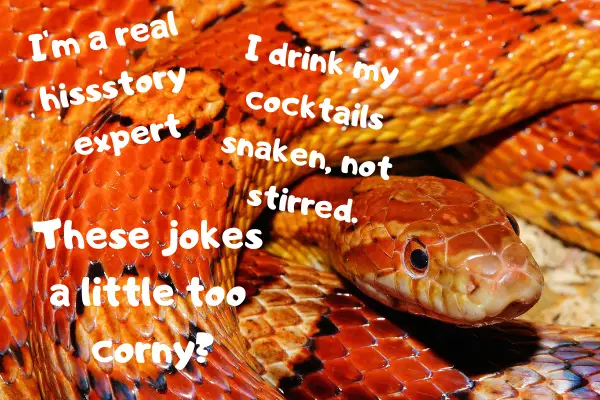
Corn snakes are up there with the ball python when it comes to the best pet snakes. These snakes are native to the united states and are found worldwide as pets.
Corn snakes make for great pet reptiles as they look stunning and are calm tempered. These snakes are fine when it comes to handling and don’t have the tendency to bite.
These snakes come in a huge variety of different morphs and are hardy snakes to keep as pets. They make good first time snakes for beginners due to the calm temperament and the vast amounts of information there is available on this snake.
As with most pet snakes, corn snake’s menu consists mainly of feeder mice. Pre-killed and frozen is preferred, as long as they are thawed before they are fed to your corn snake.
Size: Corn snakes can reach almost 6 feet (1m80) in length! Despite this, they don’t need a huge terrarium to be comfortable.
Care: Corn snakes are one of the easiest snakes to care for in captivity. They are extremely popular and it’s easy to get your hands-on quality information. Just try not to get too confused by all the different opinions people love to add into their care guides and tips and tricks articles!
Life expectancy: Corn snakes can live into their twenties. The record for a corn snake is actually 32 years old, so they are long-lived reptiles!
Cost: Corn snakes are comparable to the ball python when it comes to costs. They need a heat source which will add to the electricity bill on a monthly basis but despite that they don’t cost a lot.
Corn snakes can be bought for as long as $25-$35, but can go way over $1000 too depending on the morph. This is up to you!
Bearded anole

Bearded anoles, also known as the false chameleon, is certainly one of the best pet reptile options. They aren’t great when it comes to handling, but their funky appearance makes for a wonderful species to view and study.
They are originally come from Cuba, and are popular pet reptiles all across the world.
The false chameleon is a very calm lizard, and moves slowly and deliberately, just like a chameleon.
Beaded anoles eat mainly snails, so this may be a little more challenging to find than your standard crickets. That being said, feeding dusted and gut loaded crickets on occasion is also great nourishment for these impersonators.
Size: Bearded anoles can reach a size of about 15cm, but the majority of this size comes from the body. They are quite a bit larger than other anoles, making them a little more popular.
Care: Bearded anoles aren’t as easy as some of the other species on this list, but with some good research, it’s surely doable, even for a first timer. When it comes to reptile husbandry, knowledge goes a long way.
Cost: Cuban false chameleons are slightly more expensive than some of the other reptiles on this list. They can be found in the region of $120 to $250 but may be a lot more expensive depending on how many breeders there are in your location.
Argentine tegu
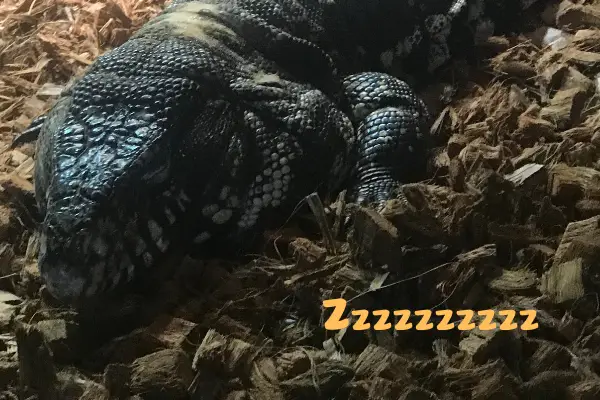
Argentine tegus are a little different on this list compared to the previous lizards. They are native to East and central South America and aren’t as popular as some of the more common species like leopard geckos and bearded dragons.
Argentine tegus are probably not your best bet if it’s your first time keeping a pet lizard, and certainly not if you’re still young. If you’re older, own your own home and have the time to dedicate to these animals however, they make extremely interesting pets.
Argentine tegus are huge compared to the other lizards on this list. They also have a ferocious bite and, even though they are docile once they are used to you, do go through a phase which can get a little dangerous if you have small children in the house.
That being said, the impressive size of these lizards is also what makes them so unique. They are extremely hardy reptiles and are not so hard to keep healthy.
Argentine tegus will eat a lot. They Are
Size: These tegus are large. They can reach up to four and a half feet in length as males. Females are a little smaller, but still extremely large when compared to lizards like bearded dragons and leopard geckos.
Care: Apart from the nasty bites and scratches and the problems you may have if they get grumpy, argentine tegus aren’t all too difficult to care for. You will need a HUGE enclosure for these bad boys though.
They are very hardy and are really rewarding if you have the space and budget for such a monster!
Life expectancy: Argentine tegu can reach the ripe old age of 20. As with most reptiles, make sure to think about whether you are ready to commit to the care of this reptile for so long.
Cost: These reptiles are quite expensive to buy. If you’re lucky you may be able to get one for around $200-$250, but they can go upwards of $2000 if there isn’t much supply, or it’s a rare morph.
The size also means that the day-to-day costs of keeping an argentine tegu are quite a bit higher.
Ackie monitor
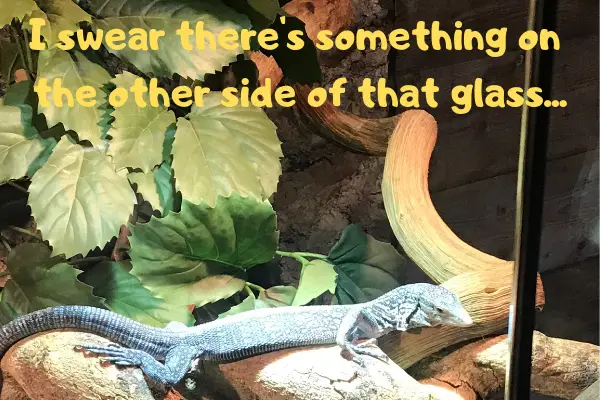
Ackie monitors are also probably not the best pet lizards for kids or beginners, but they are certainly the best monitor you can get as a pet.
Ackies are found throughout most of Australia in the wild, and are one of the smallest monitor lizards you can get as a pet.
These monitors are said to be relatively easy to care for as long as you do thorough research. The main issue is that they aren’t very commonly kept as pets. This can make it a challenge to get the right information on their husbandry.
Ackie monitors can be fed a range of different things, but their main diet consists of roaches, feeder mice, crickets and mealworms.
Size: Ackie monitors are relatively small compared to some of the larger options you have when it comes to monitors. They can reach a length of about two to three feet, so they aren’t small either!
Care: Caring for these lizards is made a little more challenging due to them not being as widely kept as pets as some other reptile species. Their size also means they need a larger enclosure and eat a little more than some of the smaller species on this list.
That being said, they make for very rewarding pets and are a wonderful and unique addition to your home.
Life expectancy: Their life expectancy isn’t all to crazy when compared to the rest of this list. You can expect your Ackie monitor to reach about 15-20 years in captivity.
Cost: Cost-wise, ackie monitors aren’t the cheapest pet reptiles you can get. They need a large enclosure, heat lamps and ample food in order to thrive in captivity. They are also expensive to buy and you can expect to pay upwards of $400 to acquire one.
They may even cost a lot more in your area, depending on how many breeders there are nearby.
Blue tong lizard/skink
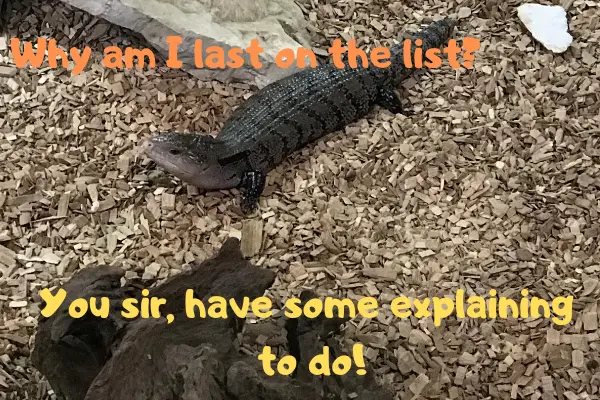
Blue tongued skinks make for great pets!
There are a variety of different blue tongue skink species, and a lot of them are native to Australia, but there are some species that come from other parts of the world too. (On this list you can see what different blue tongue skinks exist!)
These lizards make great pets, but are somewhat difficult to find. Their odd shape and magnificent blue tongue, along with them being extremely great pets, make them a great pet to own.
Blue tongue skinks eat both insects and fruits and vegetables. They are easy to feed and this isn’t often a cause for concern for blue tongue skink owners.
Size: It’s difficult to give an exact size since there are so many different kinds, but they can often reach up to about 35-40cm’s in length.
Care: Blue tongue skinks are easy to care for and are a delight as a pet. Make sure to house them alone. Apart from
Life expectancy: Blue tongue skinks can live up to 30 years. This makes them one of the longest living reptiles on this list!
Cost: Blue tongue skinks are a little more expensive than your more common leopard gecko or bearded dragon due to the difficulty of breeding these animals. However, apart from the initial purchase of a couple of hundred dollars, the day-to-day costs aren’t that high!
Conslusion
You’ve now seen 12 of the best reptiles to keep as pets. Reptiles make for wonderful and interesting pets, and can be very rewarding if cared for properly. If you need any more information on a specific species on this list, make sure to check out the different sections of our blog!
